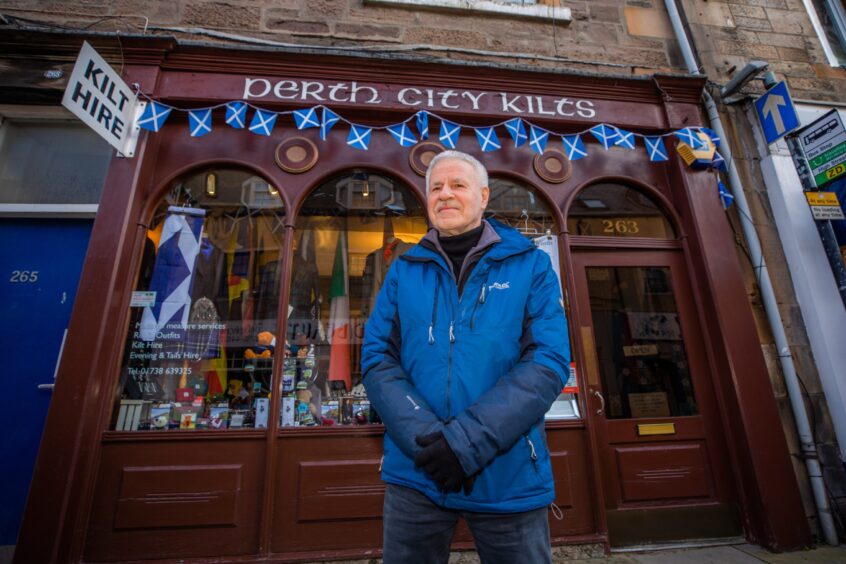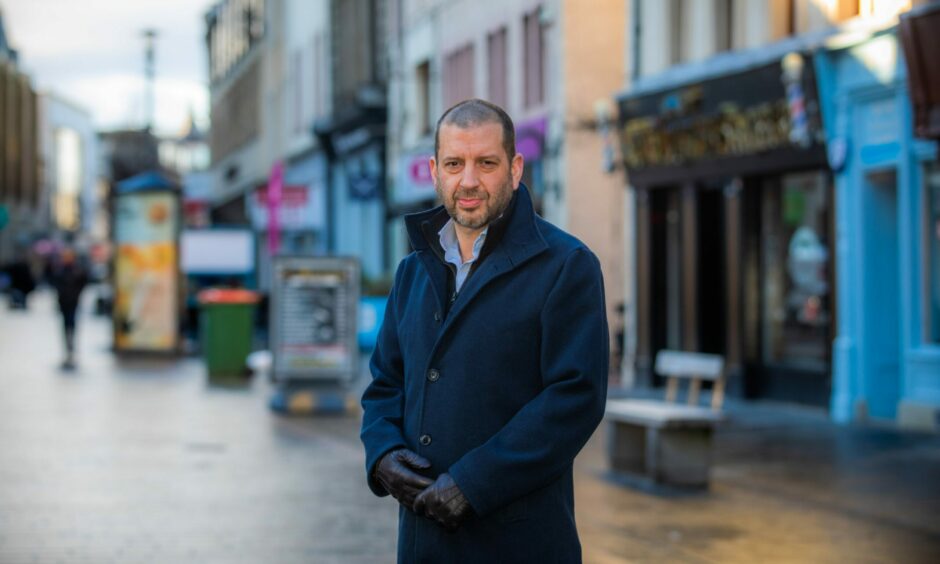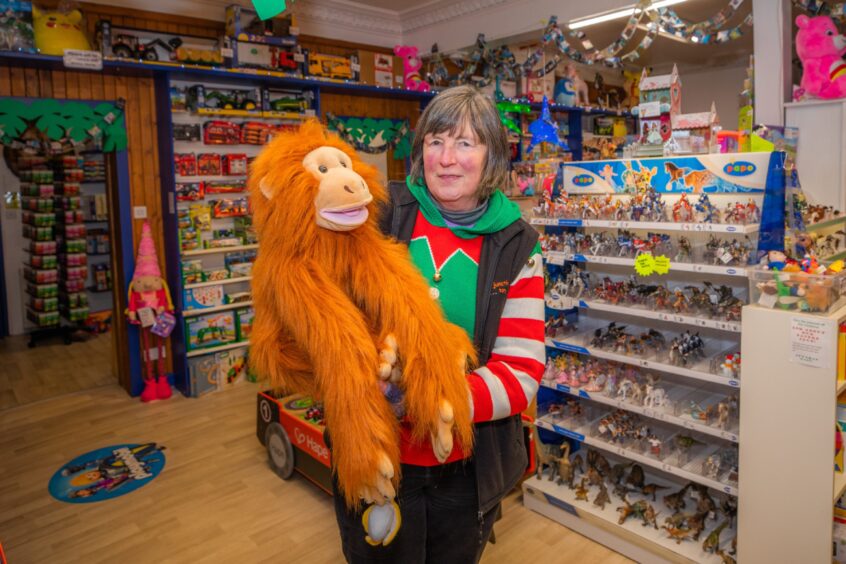
“When I came here the city centre was bustling,” says Perth shop owner David Gill.
It has been 15 years since he opened up Perth City Kilts on Old High Street and the Fair City has certainly not remained unchanged.
A pandemic, soaring costs of business and a growing dominance of online shopping have left a mark on high streets across the country.
“Perth is going backwards,” David said. Nevertheless, he labels himself an “eternal optimist” when it comes to the future of the city.
And change may be on the horizon with the much-awaited Perth Museum due to open in spring next year.
Business owners have been divided on the long-term benefit. But David is among those hoping it will help draw fresh feet to the city’s streets and make a “massive difference”.
Following our Dundee tracker, the Courier data team has launched a Perth version which will monitor the health of the high streets.
That includes 366 units across nine popular streets…
And just shy of 40 units within St John’s Shopping Centre at the heart of the city centre.
We found that on average Perth’s high streets have a vacancy rate of 16.1% – slightly below that of St John’s Shopping Centre where 16.7% of the available units were empty.
As we continue to monitor the long-term changes, our tracker will provide you with the most up-to-date information we have.
Empty or thriving – the St John’s Place divide
High Street, where David has run his shop for over a decade, unsurprisingly has the most units of all the streets we are tracking.
With 21 of those 115 units empty, it has the third worst vacancy rate of the streets – 18.3%.
It was surpassed by South Methven Street, where just over a fifth of the premises are empty, and South St John’s Place.
While the latter only had six units, four were vacant – taking the vacancy rate up to 66.7%.
Just on the other side of Perth Museum, St John’s Place is thriving with not a single vacant unit at the time of our census.
King Edward Street also only had occupied premises.
However, those three streets all had less than ten units each.
Nevertheless, longer streets like George Street and Scott Street, tracked up to its junction with Victoria Street, both have vacancy rates below 10%.
‘Growing confidence’ in the high streets
Iain Fenwick, the director of Perthshire Local, believes that the Perth Museum is beginning to drive “more confidence in the High Street from prospective investors”.
“I think you can see that with Malt and Spirits opening on St John Street and Rose House going from a small footprint to a much larger space,” he said.
“There are some good news stories right now. I believe that is driven around that same attitude that the museum has to bring people into the city centre in the short term.”
But he added: “I think it has taken a long time for this confidence to happen.”
“I have been trying to champion how local businesses can connect with the audience that is coming.
“We are starting to make changes and starting to see a more connected city centre.”
The awaited Perth Museum boost
The £27m development of the museum and the return of the Stone of Destiny has been described by council leader Grant Laing as the “culmination of our long-term cultural regeneration vision for Perth”.
But some business owners fear it may not bring the sustained long-term boost they are looking for.
Karen Christie and her family have been running toy shop Fun Junction on High Street for 20 years.
Over the two decades, she noted the biggest change has been the fall in “footfall and the internet”.
“People don’t go out looking in shops now, they are spending their time on the internet and they come in looking for specific things,” she said.
Speaking on the future of Perth’s high streets, she said: “I am concerned to be honest. I just can’t see that the Stone of Destiny is enough. People will go see it once.
“We need people to go shopping, we need people to come and wander the shops.”
Iain said creating a “hive of activity” around the museum is crucial for establishing long-term benefits and “driving interest in our city centre”.
“That means outdoor markets, it means city entertainers,” he said.
“It means getting creative with that space, helping local businesses to be able to expand outside rather than restrict the use of the space.
“We need to make sure that we’re putting on a show every time someone comes into Perth.”
St John’s Shopping Centre
With its main entrance on King Edward Street just a stone’s throw away from the new Perth Museum, St John’s Shopping Centre might also be hoping for a tourism boost.
However, how is Perth’s shopping centre faring?
St John’s Shopping Centre had only 6 empty units at the time of the census.
But there have also been recent closures, including Bubble Treats which shut on November 5.
The loss of Bubble Treats further brought down the variety of businesses within the centre.
Shopping in Perth
When the topic of changing high streets comes along, it will often also raise the question of what type of businesses are thriving.
We dove into high level data on categories of retail units – such as shopping, food and drink, etc. But also the more granular with subcategories like charity shops or shoe shops.
With the high number of hairdressers and barbers in Perth, Iain had expected quite a few to quickly flock to Perthshire Local to advertise their service.
“They just don’t need to advertise – they’ve got a really good loyal customer base, he said.
“It’s a really solid business sector in Perth city centre. There are a lot of beauticians and hairdressers but they are all busy.”
Broken down further, restaurants and cafes take the lead on the high streets
We split hairdressers and barbers but even so, they make their dominance known.
But accounting for the shopping centre pushes shops to both second and third place.
While charity shops made the list of top retail units, they were only recorded on four of the tracked streets.
The highest proportion of charity shops can be seen on Scott Street- making up 13.3% of the total units.
Vacant units
Iain emphasised that the consumer has to have a “sense of responsibility” over the state of the city centre.
“Everyone will tell you we want more independent shops, we want more quirky eateries and restaurants,” Iain added.
“We want all of this but the problem is that everybody wants to live in the 1950s but still shop in the 2020s. They are not actually shopping.
“Perth had all these independent shops, we had all this in the city centre. They’ve left because no one used them and therefore they had to go.”
Where we found vacant units, we strived to source information on how they have laid empty.
To source dates we checked archive reporting, the social media of former occupiers, Companies House, and even retail property listings.
Some units could not be dated and are not included in this analysis.
We are counting on our readers to inform us if they notice changes or have more information. You can do this by emailing us at datateam@dcthomson.co.uk
The longest standing vacant unit, according to our available information, is the former Thorntons Solicitors on George Street which shut more than six years ago.
However, it may surrender its title next summer after plans were approved to convert it into a wine bar.
Royal Bank of Scotland left their South Street unit more than five years ago.
The former High Street office of Perth and Kinross Credit Union has stood empty since it moved to George Street in 2019.
More than half of the ten on our list are vacant units on High Street.
Meanwhile, in the shopping centre, unit 1 or the former Ladbrokes has been waiting for an occupier for more than two years.
Unit 24 has not had an occupier since the start of the year – but Calendar Club returned to another unit this year.
‘It’s not a choice, it’s a responsibility’
While the Perth Museum has boosted confidence in the Fair City’s high streets, both David and Karen feel more could be done to support them.
They feel the initiative to tempt people past St Paul’s Church on High Street has fallen on the businesses.
“I always think up at the top end they have the fairs, and they have markets and buskers, if we could somehow bring it to this end,” David said.
That prompted them and some fellow shops in the area to launch a Christmas Trail inspired by Crieff’s sugar mouse competition.
“We are going to give out Christmas cuddlies to the shops,” Karen explained. “The children will be given a sheet of paper to fill out and find out which cuddly is in each shop window.”
She hopes that the trail may bring more feet their way this festive season.
And Iain emphasised that businesses themselves also need to be “more creative and more proactive” to draw out more shoppers.
“There are mechanisms that the Council must change, like the parking or getting their employees back into the office,” he said.
“But the shopper and business have to look after buying habits. It’s not a choice to shop local. It’s a responsibility to shop local.
“It’s as simple as that otherwise we are going to lose everything.”
Karen said: “They don’t need to spend all their money. They just need to come and go shopping or a couple of shops.
“If the shoppers come back, the businesses will come back.”
Where can I see more?
We will continue to monitor any changes to Perth city centre as part of this long-term project.
Our Perth high street and shopping centre tracker will always display the latest available information.
But we might not always spot changes immediately, or even get every closure date right.
We would greatly appreciate any information about any changes you might spot or even more precise information on closures.
Please do get in touch with the form below if you can help.

